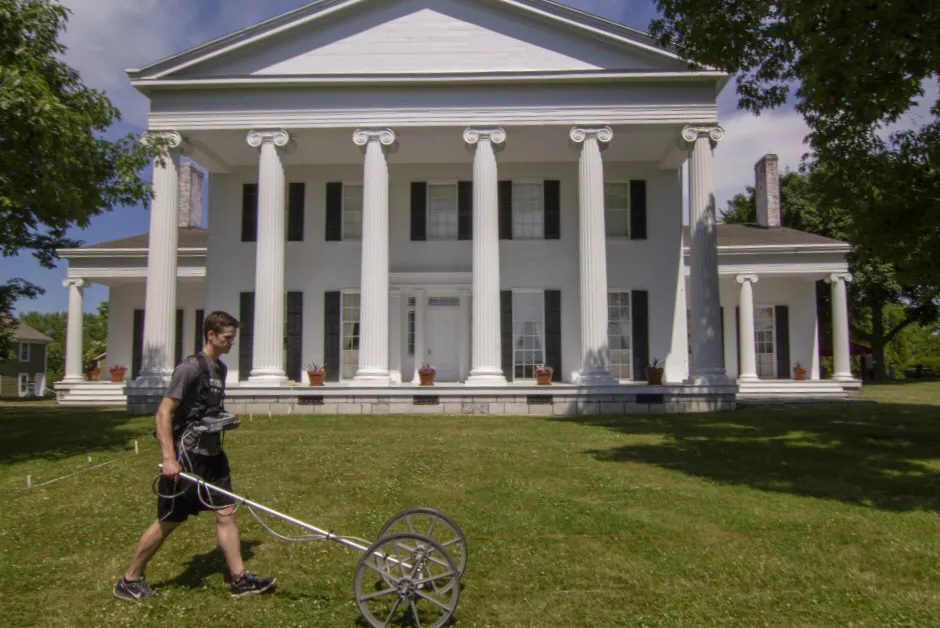Ithaca College professor Michael “Bodhi” Rogers is leading a team of students to create a digital record of Rose Hill Mansion, a national historic landmark near Geneva in New York’s Finger Lakes region.
Built in 1839, Rose Hill Mansion is a two-story Greek Revival house that sits above Seneca Lake. Once a working farm, the National Park Service declared it a national historic landmark in 1986, calling it “one of the finest examples of the Greek Revival style in the United States. Built on a monumental scale, it reflects the prosperity of Western New York as a result of the Erie Canal.” The mansion is now open seasonally for guided tours.
Rogers and his team use ground-penetrating radar and magnetometry to map below-ground features, and a 3D laser scanner to record the positional location of all standing architecture. Those readings will be used to gain a greater understanding of Rose Hill property. The scans can be helpful for preserving the site and conducting repairs, and could be used to create virtual tours for the public.
“This is an incredible opportunity for the historical society to gain a better understanding of the property,” said Kerry Lippincott, director of the Geneva Historical Society, which administers the site. “So much time and effort has been spent interpreting the interior of the mansion. Through this technology we will be able to extend the visitor experience out into the grounds.”
Ground-penetrating radar detects reflected signals from subsurface structures and plots data as overhead and side views that can be used to conduct “virtual excavations” of the site. The magnetometer used measures the Earth’s magnetic field near the ground surface so precisely that it can pick up where someone in the past dug in the dirt because digging through soil layers rearranges the iron in the soil. The 3D laser scanner pulses one million times per second to take a reading every five millimeters, while simultaneously taking digital photos. Computer software is then used to create a 3D model of structures above and below the ground.
Rogers collaborated with Cornell University associate professor Kurt Jordan to conduct similar geophysical research at the White Springs archaeological site, a location just across from Rose Hill Mansion on the west side of Seneca Lake that includes a manor house built in 1806.
“Our research at White Spring Manor resulted in a better understanding of the buried 19th century features of that historic property,” said Rogers, a professor of physics in the Department of Physics and Astronomy at Ithaca College who is also an archaeologist specializing in geophysical archaeology and historic preservation. “Due to the success at White Springs I’m excited by what we will find at the Rose Hill Mansion.”
Rogers is assisted by Ithaca College juniors Lexi Farrington and Kurt Burdick. The effort is a collaboration with Jenny Lauer, a master of landscape architecture degree candidate at the State University of New York College of Environmental Science and Forestry who is researching the landscape of Rose Hill in order to suggest design and management solutions that respect its cultural and ecological dimensions. She contacted Rogers and his team to perform the geophysical survey with hopes of uncovering the pathways, former garden beds and other landscape features contemporary to Rose Hill’s original 1839 landscape design. The project is supported by the Geneva Historical Society and funded in part by the Garden Club of America’s Corliss Knapp Engle Scholarship.
Rogers has conducted geophysical surveys of numerous historical and prehistorical sites, and completed 3D scans of several landmarks in the United States and around the world, including Abraham Lincoln’s cottage in Washington D.C.; Ulysses S. Grant’s cottage near Saratoga Springs, New York; General Philip Schuyler’s house in Schuylerville, New York; the Old Fort Johnson National Historic Landmark in Johnstown, New York; and Trim Castle in Ireland.
